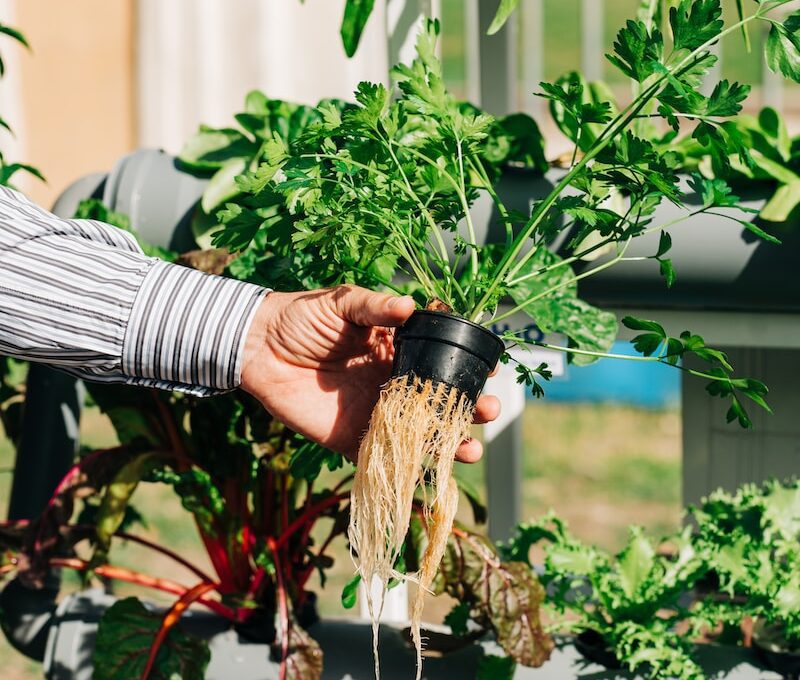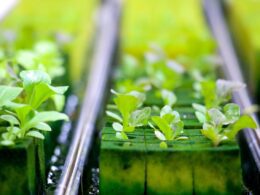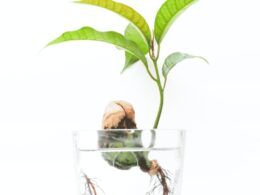The Importance of Nutrients and Water in Hydroponic Agriculture
It’s crucial to provide your hydroponic crops with the right balance of nutrients and water to ensure their growth and success. With vertical farming and other modern techniques, hydroponic agriculture has become an increasingly popular way to grow crops. Instead of soil, plants are grown in nutrient-rich water. This means that the plants rely heavily on the nutrients and water provided through the system. Without the right amount of nutrients and water, the crop yield can be severely impacted. Plants that don’t receive enough nutrients may have stunted growth or become discolored. They may also be more susceptible to disease and pests. On the other hand, too much nutrients can also be harmful to the plants, causing them to become burnt or damaged. It’s important to find the right balance to ensure that your hydroponic plants thrive. Overall, hydroponic agriculture requires careful attention to the nutrients and water provided to the plants. With the right amount of care, crops can flourish in a hydroponic system and provide a high yield of healthy produce. Remember to monitor the nutrient levels and water supply regularly to keep your hydroponic plants healthy and productive.Effects of Nutrient Deficiencies
If you don’t provide enough nitrogen to your hydroponic plants, they may start to turn yellow and have stunted growth. A phosphorus deficiency can cause slow growth and weak stems, while a lack of potassium can result in yellowing and curling of leaves. Make sure you’re giving your plants the right balance of nutrients to keep them healthy and thriving.Nitrogen Deficiency
When hydroponic plants lack nitrogen, their growth and development are stunted. This nutrient is essential for plants to produce chlorophyll, which is responsible for photosynthesis. Without enough nitrogen, plants will become yellow and their leaves will start to fall off. The plant will also have a hard time producing new leaves or stems, resulting in a weaker and smaller plant overall. To prevent nitrogen deficiency in your hydroponic plants, it’s important to monitor the nutrient levels regularly. Symptoms and solutions for nitrogen deficiency include yellowing leaves and stunted growth, which can be remedied by adding a nitrogen-rich fertilizer. Prevention techniques include using a balanced nutrient solution and adjusting the pH levels to ensure that the plants can absorb nutrients efficiently. By taking these steps, you can ensure that your hydroponic plants have enough nitrogen to grow strong and healthy.Phosphorus Deficiency
You may notice that your hydroponic plants are struggling to grow and develop properly due to a lack of phosphorus. This essential nutrient is crucial for healthy plant growth, and without it, your plants may exhibit a range of symptoms. These can include yellowing leaves, stunted growth, and weak overall plant structure. To remedy a phosphorus deficiency in your hydroponic plants, it’s important to adjust the nutrient solution accordingly. You can add a phosphorus-rich fertilizer to your hydroponic system, or adjust the pH levels to help your plants absorb the phosphorus that is already present in the nutrient solution. Remember, maintaining proper pH levels is crucial for nutrient absorption in hydroponic systems, and can make all the difference in keeping your plants healthy and thriving.Potassium Deficiency
Inadequate potassium levels can lead to a range of issues for your hydroponic crop. These include weak stems, yellowing leaves, and reduced fruit or flower production. These symptoms occur because potassium is essential for proper plant growth and development. Without enough potassium, your hydroponic plants will struggle to absorb water and nutrients, leading to stunted growth and reduced yield. To treat potassium deficiency in hydroponic plants, it’s important to add a potassium-rich nutrient solution to your hydroponic system. This will help to replenish the potassium levels in your plants and promote healthy growth. Prevention is also key in avoiding potassium deficiency. Ensure that you’re using a high-quality nutrient solution that contains potassium, and regularly monitor the pH levels in your system to ensure that your plants are able to properly absorb the nutrients they need. By addressing potassium deficiency early on, you can minimize the impact it has on the growth and yield of your hydroponic crops.What is the Shelf Life of Nutrients in Hydroponics?
When it comes to nutrient longevity in hydroponics, understanding the shelf life of essential nutrients is crucial. Unlike traditional soil-based gardening, hydroponic systems supply nutrients directly to the plant’s roots. Factors like temperature, water quality, and nutrient composition influence the lifespan of these nutrients. By monitoring nutrient levels and replenishing as needed, hydroponic growers can optimize plant health and ensure maximum yield.
Effects of Water Deficiencies
If your hydroponic system isn’t properly hydrated, your plants will suffer from a lack of essential nutrients, and growth will be stunted. Water is one of the most important nutrients for hydroponic plants, and without it, your plants won’t be able to absorb the nutrients they need to grow. When your plants aren’t getting enough water, they’ll start to wilt and lose their turgor pressure, which is what keeps them upright and firm. This is because water provides the necessary pressure to keep the cells in the plant upright and able to perform their functions. Here are three effects of water deficiencies on hydroponic plants:- Leaf wilting: When your plants aren’t getting enough water, their leaves will start to wilt and lose their shape. This is because the cells in the leaves are not able to maintain their shape without water, which causes them to collapse and lose their function.
- Reduced growth: Without enough water, your plants won’t be able to absorb the nutrients they need to grow, which will cause them to be stunted in their growth. This means that they won’t reach their full potential and may not produce as much fruit or vegetables as they could have.
- Increased susceptibility to pests and diseases: When your plants aren’t getting enough water, they’ll be weaker and more susceptible to pests and diseases. This is because their immune systems won’t be as strong, and they won’t be able to fight off infections as effectively.
Signs of Stress in Hydroponic Plants
As you observe your hydroponic plants, notice any changes in their appearance or behavior, as these could be signs of stress and indicate the need for adjustments in your system. Common stress factors for hydroponic plants include water and nutrient deficiencies, pH imbalances, and temperature fluctuations. When plants experience stress, their growth can be stunted or they may even die. One of the first signs of stress in hydroponic plants is discoloration of the leaves. If the leaves are turning yellow or brown, this could indicate a deficiency in nutrients or water. Another common sign of stress is wilting, where the leaves droop and the plant appears to be dehydrated. To troubleshoot these issues, check the pH and nutrient levels in your system and adjust accordingly. It’s also important to ensure that the plants are receiving enough water and that the temperature and humidity levels are within the appropriate range. In addition to visual cues, you may also notice changes in the behavior of your hydroponic plants when they are under stress. For example, they may stop growing or producing fruit, or they may become more susceptible to pests and diseases. If you notice any of these signs, it’s important to take action quickly in order to prevent further damage. By monitoring your plants closely and addressing any issues as soon as they arise, you can ensure that your hydroponic system is healthy and productive.Tips for Maintaining Optimal Nutrient and Water Levels
Maintaining optimal nutrient and water levels is crucial for the health and productivity of your hydroponic system, ensuring your plants thrive and flourish. Neglecting to monitor these levels can lead to a host of problems, including stunted growth, yellowing leaves, and even plant death. Here are some tips to keep your hydroponic system running smoothly and your plants happy:- Keep tabs on your pH balance: Your plants need a specific pH range to absorb nutrients effectively. If your pH balance is off, your plants won’t be able to get the nutrients they need, and their growth will suffer. Make sure to test and adjust your pH balance regularly.
- Check your nutrient solution: Over time, your nutrient solution can become depleted or unbalanced, which can lead to nutrient deficiencies in your plants. Make sure to replace your nutrient solution regularly and adjust it as needed to keep your plants healthy.
- Monitor your water levels: Your plants need a steady supply of water to thrive, but too much or too little can be harmful. Keep an eye on your water levels and adjust them as needed to ensure your plants are getting the right amount.









